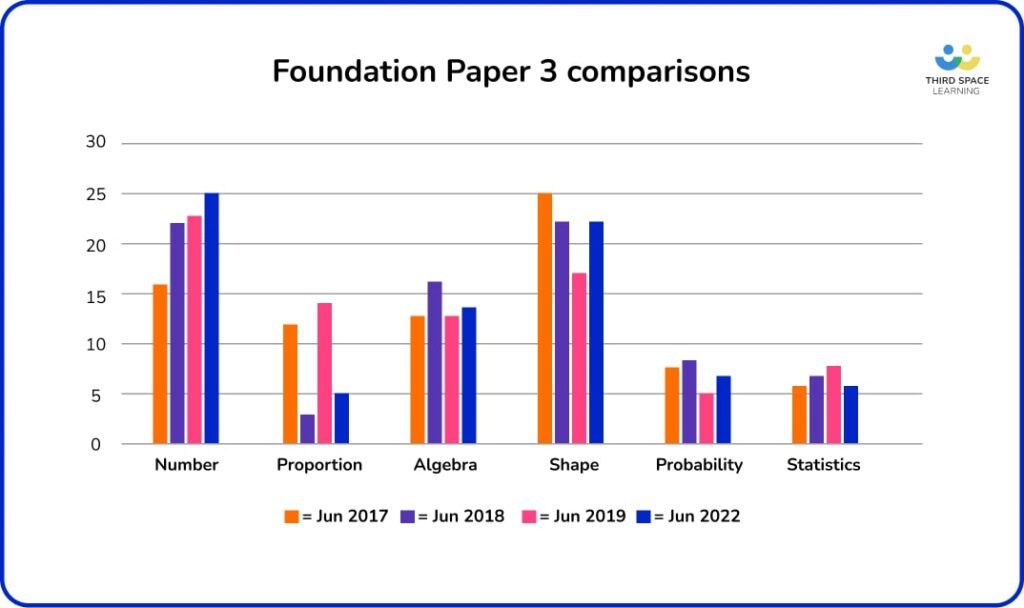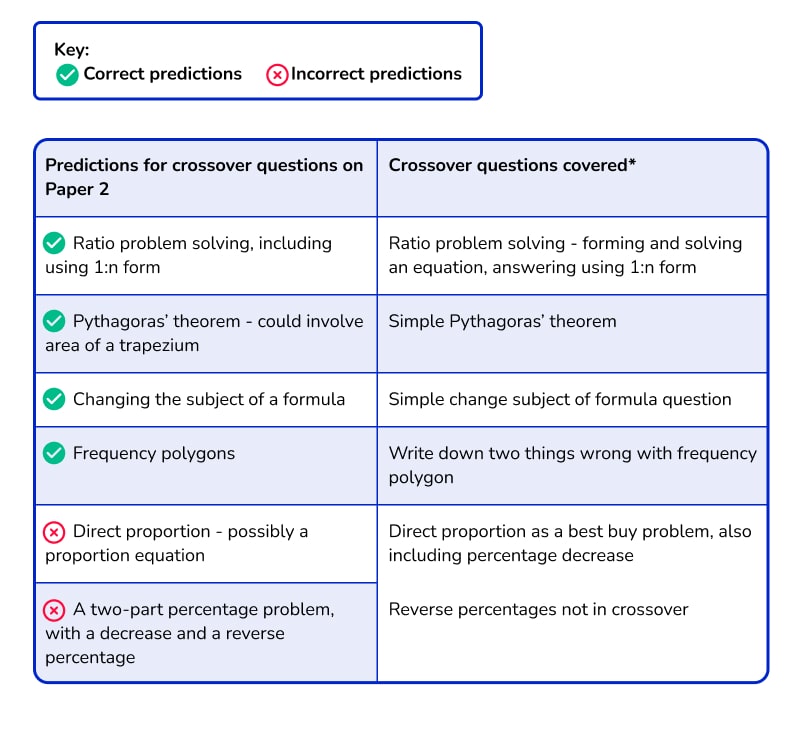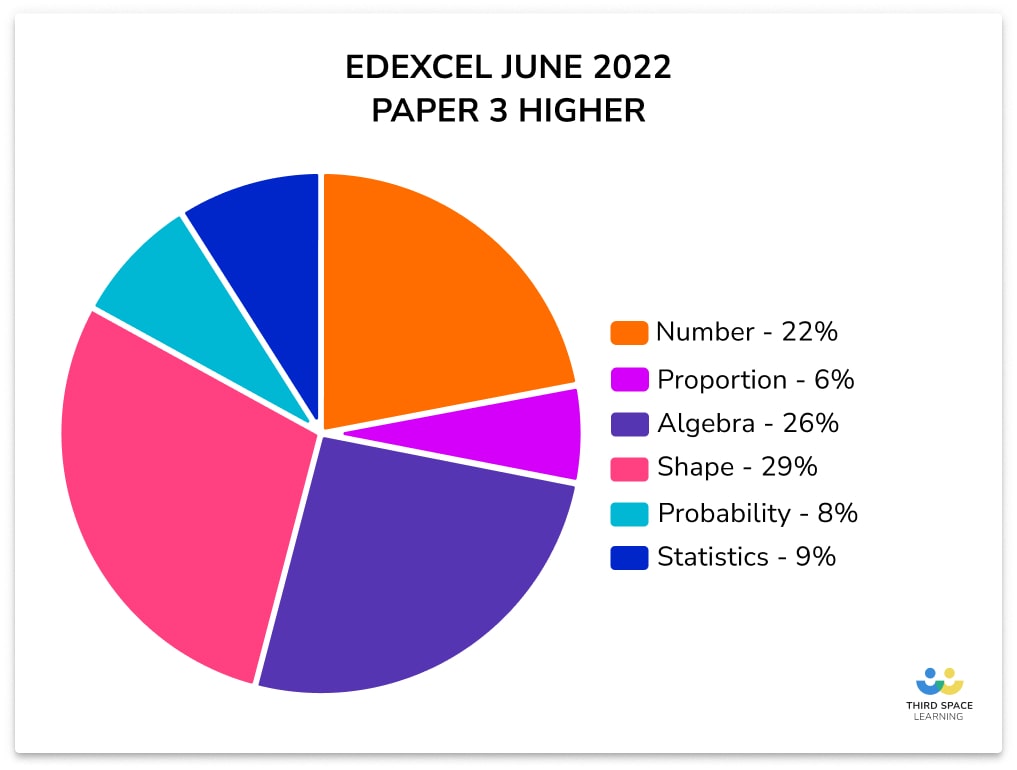GCSE Maths Paper 3 2022: Summary Of Topics & Questions
Originally published Thursday 16th June 2022
GCSE maths paper 3 2022, the final maths paper, is now behind us in this year’s GCSE exams. Let’s take a more in-depth look at Paper 3 Foundation and Higher, and then we’ll consider the series as a whole in the next blog.
When I blogged back in February, following the release of the advance information, we had a statement from Edexcel’s Maths Emporium that there could be cross-skill assessment of topics not mentioned in the advance information, but we saw very limited evidence of this on the papers.
Instead, the advance information functioned as a complete list of paper topics, and interpretation for GCSE maths paper 2 2022 and paper 3 became guesswork about which topics might be combined.
As with the previous two versions of this blog, I’ll focus on Edexcel rather than other exam boards. The following analysis is my own interpretation of GCSE maths Paper 3 and is not endorsed by Edexcel. The question papers and mark schemes have not yet been formally released.
Read more: GCSE Exams 2022 Advance Information For Maths & Summary of all GCSE maths papers 2022
GCSE Maths 2024: Stay up to date
Join our email list to stay up to date with the latest news, revision lists and resources for GCSE maths 2024. We’ll be bringing in our expert contributors to analyse each paper and identify key topic areas to focus your revision.
GCSE 2024 dates
GCSE 2024 results (when published)
GCSE results 2023
Analysis of GCSE Maths Paper 1 (2023)
Analysis of GCSE Maths Paper 2 (2023)
Analysis of GCSE Maths Paper 3 (2023)
Summary of ALL GCSE Maths Papers (2023)
Paper 3s were generally well-received
Generally, the final papers in the series appear to have been well-received. The Foundation paper ramped up nicely, with some really accessible single-markers at the start to ease students in.
Higher Paper 3 related far more transparently to the advance information than GCSE maths paper 1 2022, with far fewer topics hidden within other questions. Some of the crossover content was quite challenging though, and may have proved too difficult for the majority of Foundation candidates.
GCSE Maths Exams 2022 Advance Information Checklists
Want a resource that allows you to tick off 2022 advance information topics while linking to GCSE revision guides and worksheets to aid revision? Try our checklist covering the three main exam boards!
Download Free Now!How to understand the charts and graphs that follow
I use the same complexity classifications from my 2017-19 series GCSE Foundation and Higher analysis blogs.
- C1 – standard procedural problems, often worth one or two marks;
- C2 – problems asking candidates to explain their reasoning, interpret information from tables, diagrams or other contexts, or ‘show that’ type questions;
- C3 – non-standard multi-step problems, often requiring the application of skills from a variety of topics, worth three, four, or more marks.
Read more:
- Question Level Analysis Of Edexcel Maths Past Papers (Foundation)
- Question Level Analysis Of Edexcel GCSE Maths Higher Past Papers
Edexcel Paper 3 Foundation was a fitting send-off

The final Foundation paper felt like a nicely balanced mix of topics, many asked in a very accessible way. For lots of students, this exam was their last experience of formal mathematics, as many of them celebrated on Twitter after their final exam! Hopefully, this paper was a positive send-off for them.

As discussed shortly, the crossover content felt more variable in difficulty than in the previous two papers. The Pythagoras question and algebraic manipulation were very accessible, but the area of a trapezium/algebraic expressions question in particular felt like a real challenge for Foundation students.
Majority of Foundation Paper 3 was C1 questions
When considering the complexity measures for this paper, we see that nearly half of the paper was procedural C1 questions – similar in proportion to Foundation Paper 1. There were relatively few C2 questions requiring students to interpret graphs or charts, or explain answers.

Advance information corresponded well across Foundation papers
On Foundation Papers 1 and 2, points on the advance information list corresponded well with questions or part-questions, with fairly limited overlap. It was usually straightforward to spot which topic was being tested. The only real inclusion of anything not listed was a time-series graph appearing for ‘interpret graph’ on Paper 2.
This pattern has continued on Paper 3; topics were assessed transparently with relatively little deep embedding of topics within questions. The only potentially difficult ones to spot were:
- Writing one quantity as a percentage of another in the problem-solving question about counters in a box;
- Forming the equation needed to solve the ratio problem.
There was also a bracket expansion hidden in the trapezium question.

As in previous papers, each topic on the advance information was generally only assessed once, although there were a couple of simple two-part questions which assessed the same skill, such as rounding to significant figures.
Again, there were a few cases where multiple bullet points referred to the same question, such as angle properties of parallel lines, angles in a triangle and vertically opposite angles all examined in Q20. This was to be expected with the level of detail on the advance information for Paper 3.
Foundation Paper 3 was balanced between topic strands

The paper felt well-balanced between strands. Most of the Algebra examined was algebraic manipulation; these were the low-tariff questions on expanding a bracket, factorising, substitution and so on.
Due partly to the 5-marker on angle properties of parallel lines, the Shape strand was more equally balanced between Properties & Constructions and Calculations & Measurements than on the previous papers.
In all strands except Proportion, the Foundation Paper 3 is closest in distribution to June 2017. However, this is probably a fairly inconsequential observation with little bearing on the difficulty of each series. The June 2017 paper was perceived as very difficult at Foundation level, whereas June 2022 feels more fair.

Formula sheet was again not particularly useful
The consensus from students again is that the formula sheet was not particularly useful on Foundation. Although Pythagoras’ theorem and the formula for area of a trapezium were provided, it is likely that the algebraic/wordy presentation of these may have put candidates off, rather than assisted.
Most topics appearing on both lists were crossover content
In my Paper 2 blog, I suggested GCSE maths revision of the following potential crossover topics:

*Note that this is not a complete list of the crossover questions for Paper 3
As with the assessment of exact trigonometric values on Paper 1, there was differing assessment of reverse percentages on Paper 3. As such, this did not appear in the crossover content. Everything else in bold was included, although a couple of topics were assessed again further on in the Higher paper.
Multiple bullet points referred to the same question, such as ‘negative number’ and ‘substitute values’ indicating that students needed to perform substitution with negative numbers.
The crossover content varied in terms of difficulty, with some easier procedural Pythagoras, substitution and formulae questions, but then some really challenging work around forming algebraic expressions on the area of a trapezium problem, and forming and solving an equation for the ratio counters problem.
There was a slight discrepancy in the advance information for Paper 3; Foundation had the statement ‘form an equation’, while Higher had ‘set up and solve an equation’. These statements both appear to refer to the ratio counters problem, but due to variations in wording, I assumed these would refer to different questions – perhaps a good lesson in the dangers of over-interpretation!
Looking to help your pupils strengthen their fluency in maths? Try Third Space Learning’s free, daily and quick mental maths resource, Fluent in Five! Already used by thousands of schools across the country, take a look at our growing library of secondary resources.

Edexcel Paper 3 Higher was also fairly accessible

Higher Paper 3 seems to have been generally well-received, and feels like a fairly accessible paper. More complex algebra content, such as the linear/quadratic simultaneous equations question, was procedural or led students towards the expected final form of their answer.
Higher Paper 3 was mostly split between C1 and C3 questions
The relationship between the advance information and the exam paper was most comparable to Paper 2, in that it was more transparent and easier to spot particular topics within questions than on Paper 1. This may go some of the way to explain the differing reactions to the first and the final two papers.
This is particularly interesting when considering the complexity breakdown for Paper 3, as it’s within a couple of percentage points of Paper 1’s, with the paper split between procedural (C1) and multi-step (C3).

Advance information more transparent across Paper 2 and 3

The advance information on Paper 3 Higher again matched very well with the question paper. As predicted, multiple bullet points referred to the same question, and the information was detailed enough that it is difficult to name a required skill not mentioned on the list of advance information..
On Paper 1, there were quite a few topics hidden or embedded in other questions. However, the advance information for Paper 2 seemed more transparent, and this has continued with Paper 3. For example, the 3D trigonometry question also covered area of a trapezium, share in a ratio and Pythagoras’ theorem (but these are apparent on inspection of the question).
In fact, the only pieces of advance information that weren’t fairly obvious were:
- Expansion of single bracket (area of a trapezium/algebraic expressions);
- Set up and solve equations (ratio counters problem).

There were a few topics appearing more than once. Area of a trapezium was a surprise for me, but the two questions approached the topic in very different ways. In most cases, these repeat topics appeared in the crossover content, then again further on in the paper as part of another question.
Higher Paper 3 topic strands were distributed pretty evenly

There was a pretty even distribution of topic strands over this paper, particularly when compared to the Algebra- and Shape-heavy Paper 2.
There was quite a bit of work on percentages, accounting for the big chunk of marks in the Fractions, Decimals and Percentages category. There was also quite a bit of algebraic manipulation, with less emphasis on application – again, in contrast to Paper 2.
Pythagoras and trigonometry were hit hard on this paper (as we expected from the advance information). These two topics account for half of the marks in Shape: Calculations and Measures.
Although the two previous papers have been similar to the June 2017 series in terms of strand distribution, we see here that Paper 3 comes out looking more like June 2018. Interestingly, we seem to have similar proportions of Algebra and Shape on Paper 3s across the June series, but the amount of work in other strands varies far more.

Formula sheet continued to sit at the edge of desks
Again, students have been vocal about not finding the formula sheet useful. There is potential that the formulae for area of a trapezium and right-angled trigonometry may have been useful. However, it is likely that most students sitting the Higher paper would be confident enough with these ideas without needing to refer to the formula sheet.
That’s a wrap: a time for rest and reflection
Now that the final maths paper of this summer is out of the way, our students can breathe a sigh of relief and have a bit of a rest – at least until Results Day!
However, I know that teachers will already be starting to think ahead to next academic year.
- What lessons can be learned from this series of exams?
- Were there any surprises this year?
- Were there new styles of questions that it’s worth adapting our teaching for as we begin work with a new group of Year 11s in September?
And for those with resit groups, how will advance information impact on exams in November, given that we now have more clarity on how Edexcel’s advance information relates to their exam papers?
Over the next few weeks, I’ll be bringing you more blogs with my suggestions and ideas to answer those questions. Included will be a more detailed question-level analysis across all three papers covering both Higher and Foundation.
We will also be bringing you a detailed discussion of the GCSE maths results, featuring a deep dive into the mark schemes and GCSE grade boundaries when they’re released in August.
Free GCSE maths revision resources for schools
As part of the Third Space Learning offer to schools, the personalised online GCSE maths tuition can be supplemented by hundreds of free GCSE maths revision resources from the secondary maths resources library including:
– GCSE maths past papers
– GCSE maths worksheets
– GCSE maths questions
– GCSE maths topic list
DO YOU HAVE STUDENTS WHO NEED MORE SUPPORT IN MATHS?
Every week Third Space Learning’s specialist online GCSE maths tutors support thousands of students across hundreds of schools with weekly online 1 to 1 maths lessons designed to plug gaps and boost progress.
Since 2013 these personalised one to one lessons have helped over 150,000 primary and secondary students become more confident, able mathematicians.
Learn about the GCSE revision programme or request a personalised quote for your school to speak to us about your school’s needs and how we can help.





